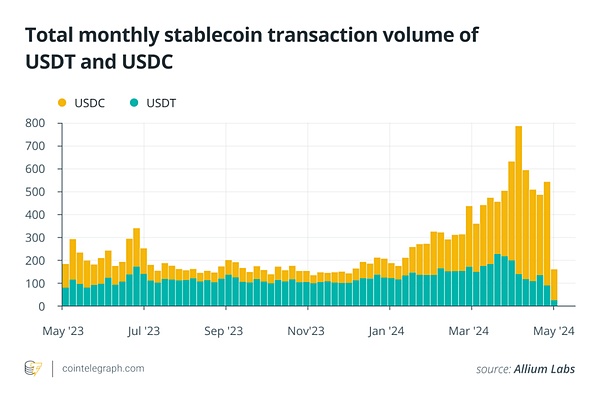Author: Daniel Ramirez-Escudero Source: Cointelegraph
Tether has long dominated the stablecoin space, thanks in large part to USDT’s status as the first fiat-backed stablecoin.
However, significant new competitors have entered the stablecoin market over the past few years, leaving USDT in a difficult position.
Trading volumes for Circle’s stablecoin USDC have been rising since 2024.
USDC’s monthly trading volume surpassed USDT for the first time in December 2023, according to payments giant Visa.
In March 2024, USDC trading volume began to rise steadily, maintaining its dominance, while USDT trading volume declined. On March 24, 2024, USDC closed the week with almost five times the volume of USDT.
On April 21, 2024, USDT's weekly trading volume continued its downward trend, shrinking to $89 billion, while USDC increased to $455 billion.

Although USDC was launched in 2018, it already accounts for 20% of the total stablecoin market.
According to a January 2024 report from cryptocurrency exchange OKX, the battle for stablecoin leadership is clearly between USDT and USDC as they together account for 90% of the entire stablecoin market.
According to on-chain data, USDC is absorbing institutional adoption of cryptocurrencies. This could threaten USDT’s supremacy as institutional investors are expected to drive the bull run.
Stablecoins race to attract institutional investors
The cryptocurrency market has undergone tremendous development over the years, from a market that was flooded with scam projects during the initial coin offering (ICO) era to a market that will attract major institutional investors after the approval of the spot Bitcoin exchange-traded fund earlier this year.
As former Binane CEO Changpeng Zhao posted on X on May 2, the crypto market has matured and may have entered a “new phase” where “compliance is very important.”
This focus on compliance is kicking off a race among companies looking to attract a new wave of investors to the crypto market — where compliant stablecoins will come to the fore.
In this regard, USDT — which has previously been the target of reports questioning the authenticity of its reserves — faces a challenge.
“USDT is an offshore stablecoin that lacks transparency and regulation, while USDC is under close scrutiny from U.S. authorities,” Ruslan Lienkha, head of markets at fintech firm and cryptocurrency exchange YouHodler, told Cointelegraph.
Tether is based in the British Virgin Islands, which is considered a tax haven for offshore banking. In contrast, USDC issuer Circle is subject to U.S. jurisdiction as it is headquartered in Boston, Massachusetts.
USDC’s strategy to establish itself as a fully regulated, transparent stablecoin may prompt Tether to try to reshape its public image. On April 1, it completed an independent audit of the “gold standard” by the American Institute of Certified Public Accountants.
The upcoming regulatory frameworks in the United States and Europe may be a factor in attracting compliant users to use USDC instead of USDT.
On April 17, the U.S. Congress introduced the Lummis-Gillibrand Payment Stablecoin Act. If it becomes law, it will affect all stablecoins in the U.S. market.
If Tether hopes to gain approval from U.S. authorities, it will need to change its offshore institutions to avoid missing out on one of the world’s largest markets.
In the EU market, the upcoming regulatory framework for crypto asset markets will require stablecoin issuers to register as electronic money issuers starting June 30.
Expecting these regulations to fully come into effect later this year, Circle puts EURC, a sister version of USDC pegged to the euro, in a favorable position.
On March 21, 2023, Circle applied for a digital asset service provider license from the French regulator.
According to the press release, this will "enable Circle to provide local services for its flagship product in the European market" and "begin the process of becoming a MiCA-compliant e-money token under the new regulatory framework." However, Tether has not yet applied to become an e-money issuer in the EU.
The consolidation of USDC trading volume may be a clue that Tether should not ignore. If it becomes the norm, Tether may have lost its crown as the king of stablecoins.
 JinseFinance
JinseFinance
 JinseFinance
JinseFinance JinseFinance
JinseFinance JinseFinance
JinseFinance JinseFinance
JinseFinance JinseFinance
JinseFinance JinseFinance
JinseFinance Sanya
Sanya Alex
Alex Cointelegraph
Cointelegraph Bitcoinist
Bitcoinist